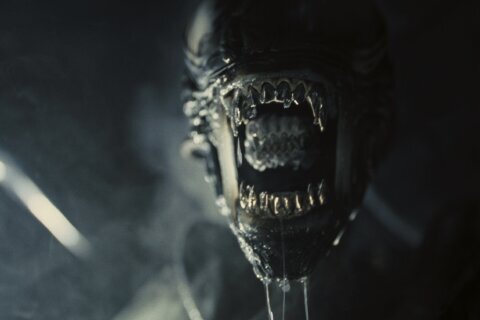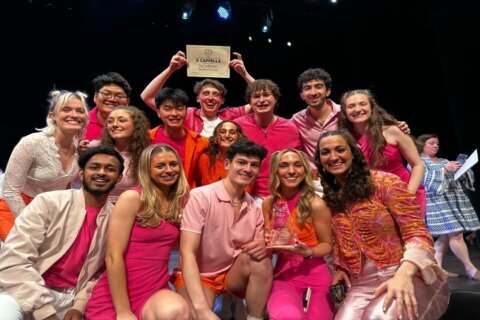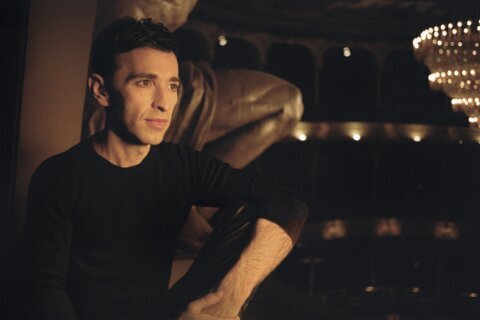WASHINGTON — It was just named Best Film by the Washington Area Film Critics Association and is a deserving front-runner for Best Picture at the Oscars.
As audiences eagerly await the release of the new musical “La La Land” (in select theaters Friday, nationwide Dec. 16), WTOP sat down with writer/director Damien Chazelle and star Emma Stone.
“Are you gonna talk in like a wacky radio voice? I know it’s all-news D.C. radio,” Stone joked with WTOP before delivering a hilarious old-time radio impression. “‘Wah, wah, wah! We’re back!'”
Such nostalgic imitation is fitting, as this magical movie follows the Technicolor romance of aspiring actress Mia (Emma Stone) and struggling jazz pianist Sebastian (Ryan Gosling), offering a present-day love letter to classic Hollywood musicals and revealing Chazelle’s two passions: movies and jazz.
“Certainly these were passions I wanted to share, but I also just wanted to make a case for these forms still being relevant,” Chazelle told WTOP. “There’s this perception of musicals as fake [and] outdated. I wanted to make a case for the genre as something that could still be modern and alive and say something about what it means to be young and chasing your dreams today.”
The project has been Chazelle’s baby for years, but one he could only make after the success of his indie film “Whiplash” (2014), which won the top prize at Sundance and an Oscar for J.K. Simmons.
“I first started writing this back in 2010,” Chazelle said. “[Gosling & Stone] were floating in my head when I was first writing. … But I was like, ‘This is never gonna happen, forget it.’ Then it took five, six years to get the movie made, and during the process I made ‘Whiplash,’ and the script wound up on their laps. … It just lined up that they were able to do it and wanted to do it together. I love that they have this built-in chemistry, but individually as well, I think they’re two of the greatest actors around.”
Indeed, Stone and Gosling have history in “Crazy, Stupid, Love” (2011) and “Gangster Squad” (2013).
“We really love to improvise,” Stone said. “From the start, from our first audition on ‘Crazy, Stupid, Love,’ they had us improvise. So you quickly get to know who you’re working with, how generous they are, how much they’re willing to play around or go to these extreme places or not. I think we both have a similar love for that and clicked in that way, so we were able to utilize some of that in this.”
You’ll also notice a cameo by J.K. Simmons as a bar owner who fires Gosling from a piano gig.
“On a personal level, I just love the guy so I’d kill to work with him at any moment,” Chazelle said. “I didn’t think he’d necessarily even be interested because it’s a relatively small role, but I just called him up and asked him … and he just jumped at the idea. But it was kind of fun. Ryan joked, his first day on set was where he plays the piano and he gets fired by J.K., and he says, ‘I see what you’re up to! You bring your actor from ‘Whiplash’ and you have him fire me on Day One. I get it. Show who’s boss!'”
There’s no question that Chazelle is the boss, controlling the tempo with his “Whiplash” editor Tom Cross to create staccato mini-montages in a series of three-beat salvos (stove, coffee, record player).
“He and I just have a shorthand,” Chazelle said. “It certainly started in ‘Whiplash.’ How does the world feel to a jazz musician? I was a jazz drummer myself, so there’s something where it’s all about rhythm. … It was all about the timing and kineticism of that. I love that you can literally create a sense of music through editing. … Even when there’s no music, it needed to still feel musical at every moment.”
Most impressive is the film’s opening single-take on the L.A. freeway, where frustrated commuters escape traffic gridlock to dance atop their cars. Technically, it’s the illusion of one continuous shot.
“There’s two illusion masks that I have to ‘fess up to,” Chazelle said, grinning. “I grew up on the East Coast and I had this perception of L.A. as this kind of horrible, unlivable place and a lot of that was informed by movies I was growing up watching, one of which was the Michael Douglas movie ‘Falling Down,’ which begins with an ‘8 1/2’ style traffic jam. … That was L.A. to me. It looked kind of hellish.”
He quickly realized there was a different, more magical side to Tinseltown.
“I moved to L.A. not thinking I’d stay very long, just because I wanted to make movies,” he said. “I fell in love with it and realized there’s this other magical, romantic side of the city. I wanted to start the movie with stuff we associate with L.A. at its worst and then build to more of a love letter to the city.”
Such romanticism shines through Gosling’s apartment, as neon green light pours in the window.
“It had these window drapes and it just occurred to me literally a few days before shooting and I talked to my D.P. about what this green light would be,” Chazelle said. “It’s certainly like the light in ‘Vertigo’ and also a little ‘Wizard of Oz’ and even Francis Ford Coppola’s ‘Dracula’ has this incredible green mist. That kind of green is a color you saw a lot in old Technicolor movies and you don’t really see anymore, so I just kind of loved it. Everyone looked at me like, ‘What the hell are you doing?'”
Equally nostalgic is the dream finale, recalling Vincente Minnelli’s “An American in Paris” (1951).
“I’m not sure what came first, just the idea of the emotion I wanted at the end of the movie or this idea of doing a big dream ballet from those old movies,” Chazelle said. “Why don’t we do that anymore? Movies that were Hollywood studio mainstream movies for the broad public in the ’50s would stop the story and just go into pure music. There was something brazen and audacious to that.”
Of course, none of these directing concepts would matter if the tunes themselves weren’t fantastic. Enter Justin Hurwitz (music), Benj Pasek and Justin Paul (lyrics), from the earworm “City of Stars” to the melancholic “Audition (The Fools Who Dream),” which is equally inspiring and heartbreaking.
While Stone sang previously in Broadway’s “Cabaret,” moviegoers may be pleasantly surprised by her pipes. Perhaps it’s because the lyrics reflect her own initial real-life struggle to make it in showbiz.
“To all of us, to anyone that lives a creative life, it’s a sort of insane existence in so many ways,” Stone said. “I can’t imagine living any other way than getting to be a creative person, but it’s also so crazy a lot of the time. You’re hanging these hopes on things outside of you, or you’re creating things and hoping people respond to them. I don’t know that it has any bearing on how outwardly ‘successful’ you are … because I think all success is inward anyway, and that’s what I think that song is about.”
Fittingly, the film opens with Stone spilling coffee down her shirt just before an important audition.
“It’s funny, I’ve been trying to remember my horrible audition stories,” Stone said. “Only a few really stand out. What stands out for me more than anything is the periods of just not getting auditions. The periods of really being ignored and going on a bunch of auditions and getting rejected from all of those and no one’s calling you! That was so brutal. … That feeling of not even getting a chance.”
There’s a point where Mia debates giving up. Was there ever a moment like that for Stone?
“I mean, I still know the feeling!” Stone joked, before getting real. “I moved here when I was 15 and my mom was with me for periods of it, and there was one time where I was just crying on the floor of the apartment we were renting. I was like, ‘I can’t do it!’ She was excited like, ‘Ready to go home?’ And I was like, ‘I also can’t do that!.’ … Anyone saying, ‘You should just go home’ was sort of my car horn.”
By “car horn,” she refers to Gosling’s character, who routinely slams his horn to get attention.
“That was in the script,” Chazelle said. “This very grating [sound], stubborn as the character. … But it was also kind of a funny musical device. The movie needed to be pregnant with music at every moment, so even city sounds that would normally be annoying serve as little bits of music or melody.”
Now, unlike the car horn of Faye Dunaway’s head pressed on the steering wheel in “Chinatown” (1974), “La La Land” has reclaimed L.A. not as a place of tragic corruption but as a place of magic. Look no further than the magical moment at Griffith Observatory, where Stone and Gosling recreate a scene from “Rebel Without a Cause” (1955) before lifting off into the stars of the planetarium.
Audiences will look up with wide eyes like Stone’s final gaze at the end of “Birdman” (2014). You’ll recall that film won Best Director for Alejandro G. Iñárritu. Expect a similar result for Chazelle.
“Both of them have incredibly clear visions,” Stone said. “They’re both auteurs writing and directing their own stuff. There were a lot of those kind of single-take feelings in ‘La La Land,’ long single takes that were choreographed and we rehearsed for a long time. And both movies have to do with actors in some way. So aside from all those comparisons, they’re totally different in terms of personality. Equally passionate, but just very different guys. Although, I think they’d get along very very well.”
Tune in Friday morning for my review of the movie. HINT: It might just be my favorite film of the year.








